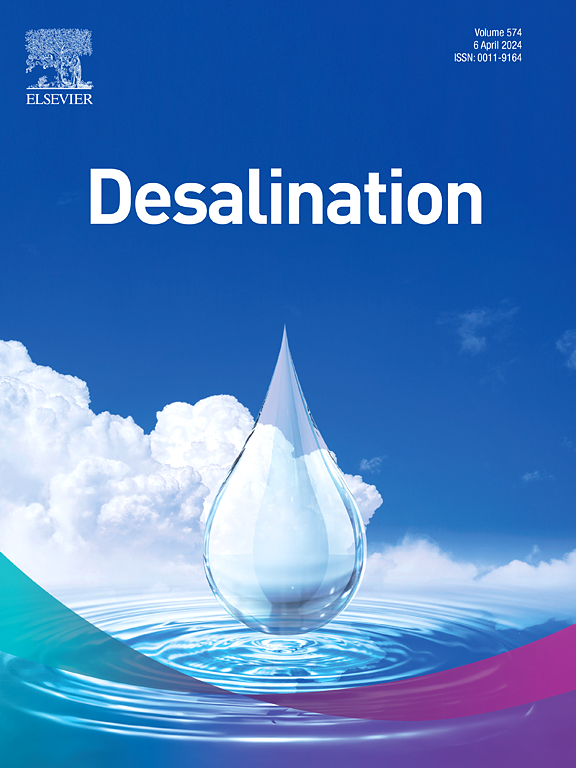Three-dimensional carbon nanotube sponge supported LiMn2O4 hybrid for electrochemical lithium extraction with high capacity and stability
IF 8.3
1区 工程技术
Q1 ENGINEERING, CHEMICAL
引用次数: 0
Abstract
LiMn2O4 (LMO) has been widely studied as a green and cost-effective electrochemical active material for lithium extraction from brine. Despite its potential, LMO faces inherent challenges such as poor conductivity and low stability, which lead to high energy consumption and rapid performance decay, thereby limiting its practical application. Here, a freestanding carbon nanotube sponge (CS) supported LMO (LMO@CS) hybrid is constructed through in-situ electrochemical anodic oxidation growth and hydrothermal lithiation. The three-dimensional (3D), conductive, and hydrophilic CS substrate can efficiently disperse the LMO nanoparticles and connect them, which endows the hybrid with reduced charge transfer resistance and shortened ion diffusion pathways, as well as high separation capability and enhanced structural stability. Consequently, when serving as a lithium extraction electrode, the optimal LMO@CS hybrid exhibits a lithium capacity of up to 4.12 mmol g−1 and a high capacity retention of 87.8 % over 100 cycles. By employing the LMO@CS//Ag system in synthetic brine, the separation factors of Li+/Na+, Li+/K+, and Li+/Mg2+ reach 259, 73, and 76 after 10 cycles, respectively. Furthermore, the CS substrate can be recycled through an environmentally friendly process, extending its usability even after the LMO@CS electrode deteriorates over extended use. This study highlights the effectiveness of the 3D and binder-free LMO@CS hybrid design in maximizing the performance of pristine LMO and offers a promising route for developing high-performance electrodes in electrochemical lithium extraction.

三维碳纳米管海绵负载的LiMn2O4杂化物具有高容量和稳定性的电化学锂萃取
LiMn2O4 (LMO)作为一种绿色、经济高效的卤水提锂电化学活性材料得到了广泛的研究。尽管具有潜力,但LMO也面临着导电性差、稳定性低等固有挑战,导致其能耗高、性能衰减快,从而限制了其实际应用。通过原位电化学阳极氧化生长和水热锂化,构建了一种独立的碳纳米管海绵(CS)负载的LMO (LMO@CS)杂化材料。三维(3D)、导电性和亲水性的CS衬底可以有效地分散和连接LMO纳米颗粒,从而使杂化物具有降低电荷转移阻力和缩短离子扩散途径的特点,具有较高的分离能力和增强的结构稳定性。因此,当用作锂提取电极时,最佳LMO@CS杂化材料显示出高达4.12 mmol g−1的锂容量,并且在100次循环中保持87.8%的高容量。在合成卤水中采用LMO@CS//Ag体系,循环10次后,Li+/Na+、Li+/K+和Li+/Mg2+的分离系数分别达到259、73和76。此外,CS基板可以通过环保工艺回收,即使LMO@CS电极在长时间使用后恶化,也可以延长其可用性。该研究强调了3D和无粘结剂LMO@CS混合设计在最大化原始LMO性能方面的有效性,并为开发电化学锂提取的高性能电极提供了一条有前途的途径。
本文章由计算机程序翻译,如有差异,请以英文原文为准。
求助全文
约1分钟内获得全文
求助全文
来源期刊

Desalination
工程技术-工程:化工
CiteScore
14.60
自引率
20.20%
发文量
619
审稿时长
41 days
期刊介绍:
Desalination is a scholarly journal that focuses on the field of desalination materials, processes, and associated technologies. It encompasses a wide range of disciplines and aims to publish exceptional papers in this area.
The journal invites submissions that explicitly revolve around water desalting and its applications to various sources such as seawater, groundwater, and wastewater. It particularly encourages research on diverse desalination methods including thermal, membrane, sorption, and hybrid processes.
By providing a platform for innovative studies, Desalination aims to advance the understanding and development of desalination technologies, promoting sustainable solutions for water scarcity challenges.
 求助内容:
求助内容: 应助结果提醒方式:
应助结果提醒方式:


